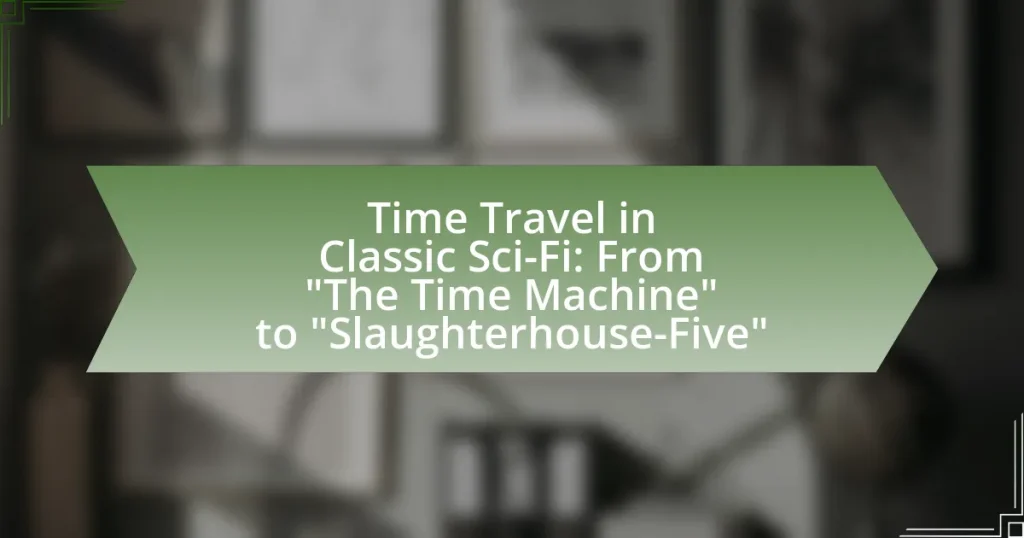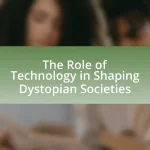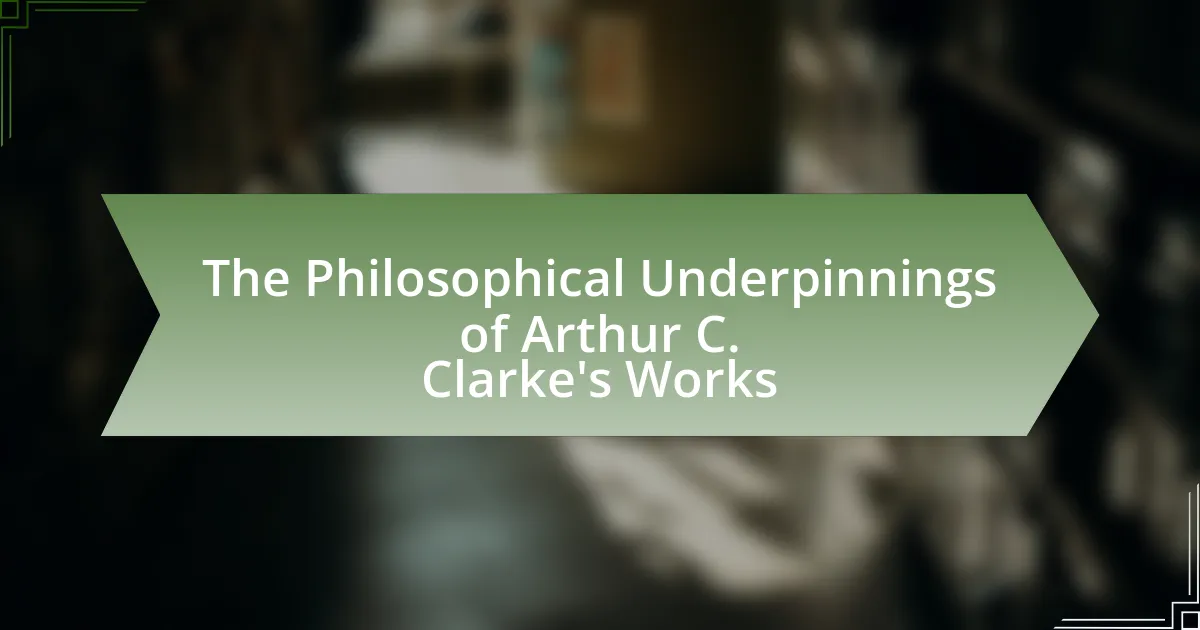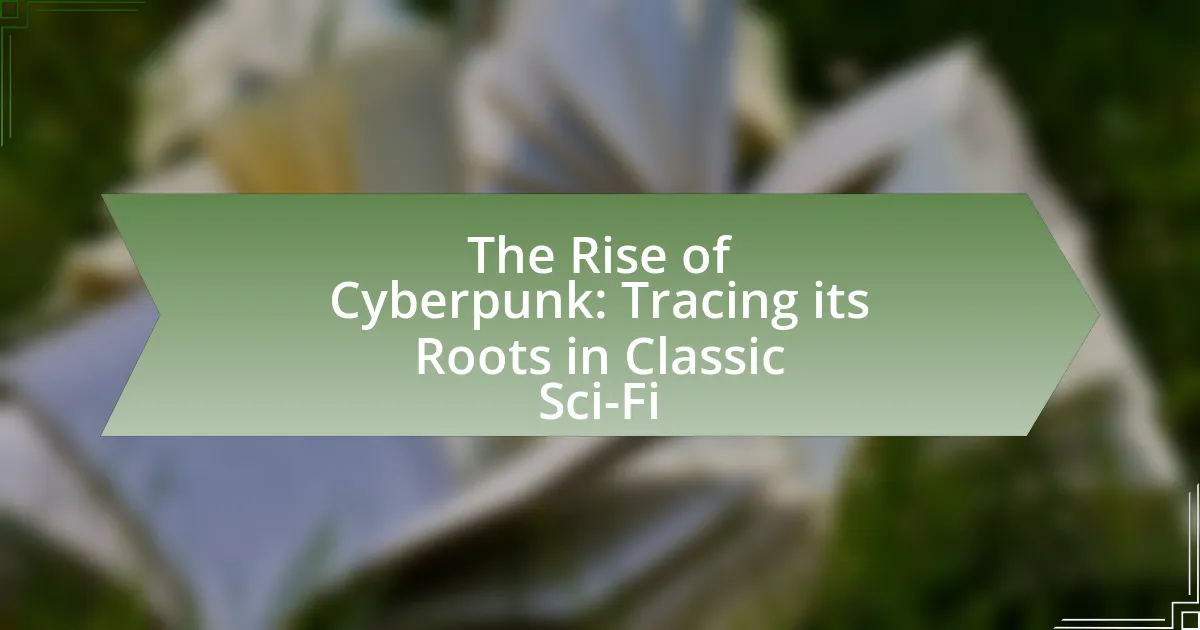Time travel in classic science fiction is a prominent theme that explores the movement between different points in time, often through advanced technology or supernatural means. Key works such as H.G. Wells’ “The Time Machine” and Kurt Vonnegut’s “Slaughterhouse-Five” illustrate the implications of time travel on human existence, morality, and societal issues. The article examines how these narratives portray time travel as a mechanism for exploring themes like fate versus free will, the consequences of technological advancement, and the nature of time itself. Additionally, it discusses the narrative techniques employed by authors to depict time travel and the philosophical questions raised by these stories, highlighting their relevance to contemporary readers.

What is Time Travel in Classic Sci-Fi?
Time travel in classic sci-fi refers to the concept of moving between different points in time, often facilitated by advanced technology or supernatural means. This theme is prominently featured in works such as H.G. Wells’ “The Time Machine,” where a time traveler explores the distant future, and Kurt Vonnegut’s “Slaughterhouse-Five,” which presents a nonlinear narrative of a soldier’s experiences across time. These narratives often explore the implications of time travel on human existence, morality, and the nature of reality, reflecting societal anxieties and philosophical questions of their respective eras.
How has time travel been portrayed in classic science fiction literature?
Time travel in classic science fiction literature has often been portrayed as a mechanism for exploring the consequences of human actions across different timelines. In H.G. Wells’ “The Time Machine,” time travel serves as a means to critique social class disparities, illustrating a future where humanity has evolved into distinct species. Similarly, Kurt Vonnegut’s “Slaughterhouse-Five” presents time travel as a non-linear experience, reflecting the protagonist’s struggles with trauma and the inevitability of fate. These works exemplify how time travel is utilized not just as a plot device, but as a profound commentary on human nature and societal issues.
What are the key themes associated with time travel in these works?
Key themes associated with time travel in classic sci-fi works include the exploration of fate versus free will, the consequences of technological advancement, and the nature of time itself. In “The Time Machine,” H.G. Wells examines the impact of social class and evolution through time travel, suggesting that humanity’s future is shaped by its present choices. Kurt Vonnegut’s “Slaughterhouse-Five” presents time as non-linear, emphasizing the inevitability of events and the trauma of war, illustrating how time travel can serve as a mechanism for coping with past experiences. These themes highlight the philosophical and ethical implications of time travel, reflecting on human existence and the choices that define it.
How do different authors interpret the concept of time travel?
Different authors interpret the concept of time travel in various ways, often reflecting their philosophical, scientific, and narrative perspectives. H.G. Wells, in “The Time Machine,” presents time travel as a physical journey through time, exploring social evolution and the consequences of technological advancement. Kurt Vonnegut, in “Slaughterhouse-Five,” depicts time travel as a non-linear experience, emphasizing fatalism and the impact of trauma on perception. Ray Bradbury, in “A Sound of Thunder,” illustrates the butterfly effect, where small actions in the past can drastically alter the future, highlighting the interconnectedness of time. These interpretations showcase the diverse thematic explorations of time travel, from its implications on society to the psychological effects on individuals.
Why is “The Time Machine” significant in the context of time travel narratives?
“The Time Machine” is significant in the context of time travel narratives because it is one of the earliest works to explore the concept of time travel as a scientific possibility rather than a mere fantasy. H.G. Wells introduced the idea of a machine that could transport individuals through time, fundamentally shaping the genre by establishing time travel as a legitimate subject for speculative fiction. The narrative not only examines the implications of time travel on society and human evolution but also critiques contemporary social issues, such as class disparity and technological advancement. This dual focus on scientific innovation and social commentary has influenced countless subsequent works in the genre, making “The Time Machine” a foundational text in the development of time travel literature.
What are the main ideas presented in H.G. Wells’ “The Time Machine”?
The main ideas presented in H.G. Wells’ “The Time Machine” include the exploration of time travel, the critique of social class disparities, and the consequences of technological advancement. The protagonist, known as the Time Traveler, constructs a machine that allows him to journey into the distant future, where he encounters two distinct species: the Eloi, representing a complacent upper class, and the Morlocks, symbolizing a laboring lower class. This dichotomy illustrates Wells’ commentary on the potential future of humanity shaped by class division and the impact of industrialization. The narrative also raises questions about evolution and the fate of civilization, suggesting that unchecked progress may lead to societal decay.
How did “The Time Machine” influence subsequent time travel stories?
“The Time Machine” significantly influenced subsequent time travel stories by establishing foundational concepts such as the mechanics of time travel, the exploration of social and evolutionary themes, and the moral implications of altering time. H.G. Wells introduced the idea of a machine that allows travel through time, which became a staple in later narratives, inspiring works like “Back to the Future” and “Doctor Who.” Additionally, the novel’s portrayal of future societies and the consequences of technological advancement set a precedent for exploring dystopian and utopian themes in time travel literature, as seen in stories like “The Time Traveler’s Wife” and “Slaughterhouse-Five.” The impact of Wells’ work is evident in how it shaped the narrative structure and thematic depth of time travel stories that followed.
What role does time travel play in “Slaughterhouse-Five” by Kurt Vonnegut?
Time travel in “Slaughterhouse-Five” serves as a narrative device that illustrates the non-linear nature of time and the inevitability of fate. The protagonist, Billy Pilgrim, experiences time as a series of moments rather than a chronological sequence, reflecting the Tralfamadorian philosophy that all moments exist simultaneously. This perspective allows Vonnegut to explore themes of free will, trauma, and the impact of war, particularly the bombing of Dresden during World War II. The use of time travel emphasizes the absurdity of human existence and the struggle to find meaning in a chaotic world, as seen through Billy’s disjointed experiences across different times and places.
How does Vonnegut’s approach to time travel differ from that of Wells?
Vonnegut’s approach to time travel differs from Wells’ by emphasizing the non-linear and deterministic nature of time, as seen in “Slaughterhouse-Five,” where the protagonist, Billy Pilgrim, experiences moments from his life out of sequence, illustrating the idea that all moments exist simultaneously. In contrast, Wells’ “The Time Machine” presents time travel as a linear journey through the future, where the protagonist actively navigates through time, suggesting a more traditional and exploratory view of temporal mechanics. This distinction highlights Vonnegut’s focus on fatalism and the inevitability of events, while Wells explores the potential for change and discovery within a structured timeline.
What philosophical questions does “Slaughterhouse-Five” raise about time and free will?
“Slaughterhouse-Five” raises significant philosophical questions about the nature of time and free will, particularly through the concept of time as non-linear and predetermined. The protagonist, Billy Pilgrim, experiences time in a way that suggests all moments exist simultaneously, challenging the traditional view of time as a linear progression. This perspective implies that free will may be an illusion, as events are predetermined and individuals cannot change their fates. The narrative structure, which jumps between different points in Billy’s life, reinforces the idea that past, present, and future are interconnected, leading to questions about the extent of human agency in shaping one’s destiny. The Tralfamadorians, who perceive time differently, further emphasize the notion that all moments are fixed, raising doubts about the meaningfulness of choice and the impact of individual actions.
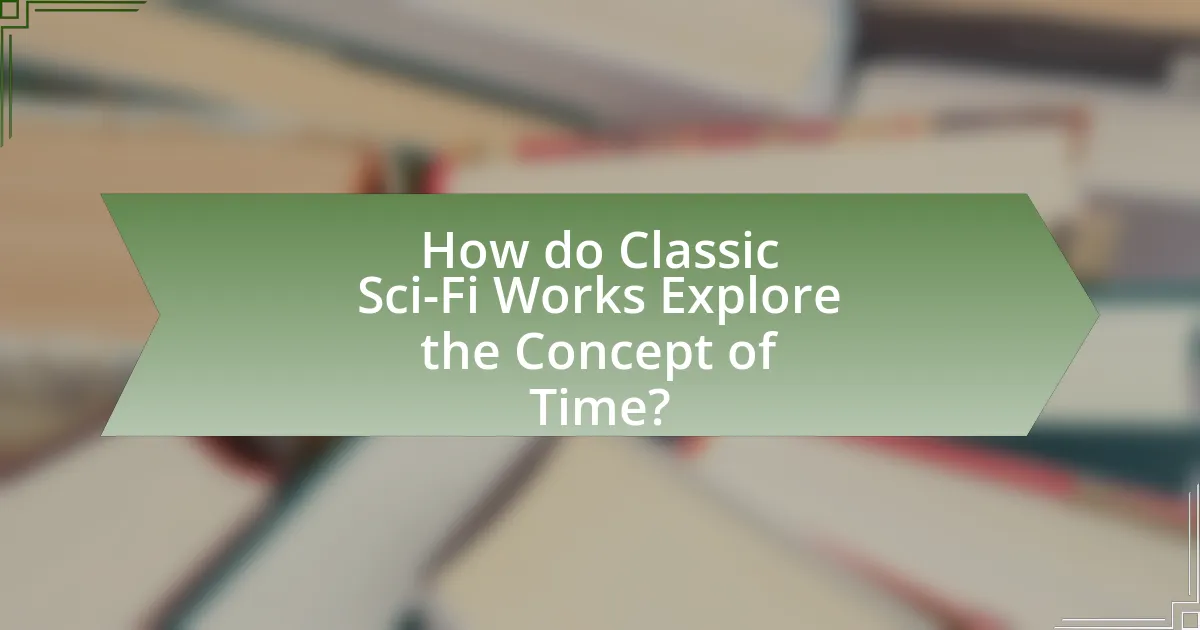
How do Classic Sci-Fi Works Explore the Concept of Time?
Classic sci-fi works explore the concept of time through various narrative techniques and philosophical inquiries. For instance, H.G. Wells’ “The Time Machine” introduces the idea of time as a fourth dimension, allowing characters to travel forward and backward, which raises questions about the nature of progress and the consequences of human actions over time. Similarly, Kurt Vonnegut’s “Slaughterhouse-Five” presents time as non-linear, illustrating how moments can be experienced out of sequence, thereby challenging traditional perceptions of time and fate. These works utilize time travel not only as a plot device but also as a means to examine human existence, morality, and the impact of historical events, demonstrating that time is both a physical and a philosophical construct in the realm of science fiction.
What narrative techniques are used to depict time travel in these stories?
Narrative techniques used to depict time travel in these stories include non-linear storytelling, flashbacks, and the use of unreliable narrators. Non-linear storytelling allows authors to present events out of chronological order, creating a sense of disorientation that mirrors the experience of time travel, as seen in “Slaughterhouse-Five.” Flashbacks serve to illustrate characters’ memories and experiences across different time periods, effectively linking past and future, which is a technique prominently featured in “The Time Machine.” Unreliable narrators, such as Billy Pilgrim in “Slaughterhouse-Five,” challenge readers’ perceptions of time and reality, emphasizing the subjective nature of time travel. These techniques collectively enhance the thematic exploration of time and its complexities in classic sci-fi literature.
How do authors manipulate time to enhance storytelling?
Authors manipulate time in storytelling by employing techniques such as non-linear narratives, flashbacks, and time dilation to create tension and deepen character development. For instance, in H.G. Wells’ “The Time Machine,” the protagonist travels to different eras, allowing readers to explore the consequences of time on society and human evolution. Similarly, Kurt Vonnegut’s “Slaughterhouse-Five” uses a fragmented timeline to reflect the chaotic nature of war and trauma, illustrating how time can be perceived differently by individuals. These methods not only enhance the thematic depth of the narratives but also engage readers by challenging their understanding of time and its impact on human experience.
What impact does non-linear storytelling have on reader perception?
Non-linear storytelling significantly alters reader perception by engaging them in a more active interpretation of the narrative. This narrative structure challenges traditional chronological storytelling, prompting readers to piece together events and themes, which can enhance emotional engagement and cognitive involvement. Research indicates that non-linear narratives, such as those found in “Slaughterhouse-Five,” encourage readers to reflect on the nature of time and memory, leading to a deeper understanding of the characters’ experiences and the overarching themes of the story. This engagement can result in a more personalized and impactful reading experience, as readers must navigate the complexities of the plot and draw connections between disparate events.
Why do classic sci-fi authors choose time travel as a central theme?
Classic sci-fi authors choose time travel as a central theme to explore complex ideas about causality, morality, and the human experience. Time travel allows authors to manipulate timelines, creating scenarios that challenge the characters’ understanding of fate and free will. For instance, H.G. Wells’ “The Time Machine” examines social evolution and the consequences of technological advancement, while Kurt Vonnegut’s “Slaughterhouse-Five” addresses the trauma of war and the nature of time itself. These narratives provide a framework for discussing philosophical questions and societal issues, making time travel a compelling device in classic science fiction.
What societal issues are addressed through the lens of time travel?
Time travel in classic sci-fi addresses societal issues such as the consequences of technological advancement, the impact of war, and the exploration of social inequality. For instance, H.G. Wells’ “The Time Machine” critiques class disparity by depicting a future where society is divided into the Eloi and Morlocks, reflecting concerns about industrialization and social stratification. Similarly, Kurt Vonnegut’s “Slaughterhouse-Five” uses time travel to comment on the trauma of war and the inevitability of fate, highlighting the psychological effects of conflict on individuals and society. These narratives serve as a lens to examine and critique contemporary societal challenges, making them relevant across different eras.
How does time travel serve as a metaphor in these narratives?
Time travel serves as a metaphor in these narratives by illustrating the complexities of human experience, particularly the interplay between past, present, and future. In H.G. Wells’ “The Time Machine,” time travel symbolizes the consequences of social evolution and the potential for humanity’s decline, reflecting Victorian anxieties about progress. Similarly, in Kurt Vonnegut’s “Slaughterhouse-Five,” the protagonist’s non-linear journey through time represents the trauma of war and the inevitability of fate, emphasizing the struggle to find meaning in chaotic experiences. Both narratives utilize time travel to explore existential themes, highlighting how individuals grapple with their histories and the impact of time on identity and morality.
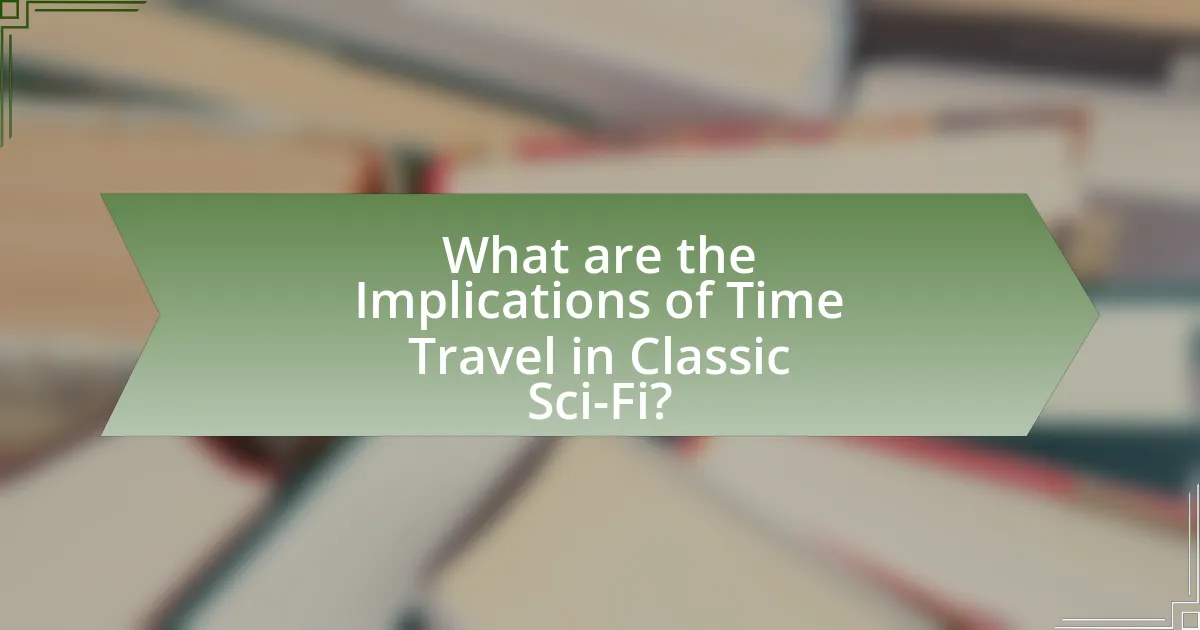
What are the Implications of Time Travel in Classic Sci-Fi?
The implications of time travel in classic sci-fi include the exploration of causality, the nature of time, and the ethical dilemmas associated with altering past events. In H.G. Wells’ “The Time Machine,” time travel serves as a vehicle to critique social class disparities and the consequences of human evolution. Similarly, Kurt Vonnegut’s “Slaughterhouse-Five” uses time travel to illustrate the non-linear nature of time and the impact of trauma on perception. These narratives highlight how time travel can challenge the understanding of free will and determinism, as characters grapple with the consequences of their actions across different timelines.
How does time travel challenge our understanding of history and reality?
Time travel fundamentally challenges our understanding of history and reality by introducing the possibility of altering past events, which raises questions about causality and the nature of time itself. In classic sci-fi literature, such as H.G. Wells’ “The Time Machine,” the narrative explores how changes in the past could lead to divergent futures, suggesting that history is not a fixed sequence but rather a fluid construct influenced by actions taken across time. This concept is further exemplified in Kurt Vonnegut’s “Slaughterhouse-Five,” where the protagonist experiences time non-linearly, illustrating that reality may not be as straightforward as perceived. These narratives compel readers to reconsider the linearity of time and the reliability of historical accounts, as they imply that multiple timelines and realities could coexist, fundamentally altering our perception of truth and existence.
What are the consequences of altering past events in these stories?
Altering past events in time travel stories often leads to significant and unpredictable consequences, including the creation of alternate timelines, paradoxes, and the alteration of characters’ fates. For instance, in “The Time Machine” by H.G. Wells, the protagonist’s attempts to change the past result in a future where humanity has evolved into two distinct species, illustrating how interference can drastically reshape reality. Similarly, in Kurt Vonnegut’s “Slaughterhouse-Five,” the protagonist experiences time non-linearly, demonstrating that changes to past events can lead to traumatic repercussions and existential dilemmas. These narratives highlight the complex interplay between time, choice, and consequence, emphasizing that even minor alterations can have far-reaching effects on the fabric of time and existence.
How do characters cope with the complexities of time travel?
Characters cope with the complexities of time travel by employing various strategies such as adapting to new timelines, grappling with the consequences of their actions, and seeking to understand the mechanics of time. For instance, in H.G. Wells’ “The Time Machine,” the protagonist learns to navigate different eras, which requires him to adjust his worldview and expectations. Similarly, in Kurt Vonnegut’s “Slaughterhouse-Five,” the character Billy Pilgrim experiences time non-linearly, leading him to accept the inevitability of fate and the randomness of existence. These coping mechanisms highlight the psychological and philosophical challenges posed by time travel, illustrating how characters must reconcile their experiences with the broader implications of altering time.
What lessons can contemporary readers learn from classic time travel narratives?
Contemporary readers can learn about the complexities of time, morality, and human nature from classic time travel narratives. These stories often explore the consequences of altering the past, as seen in H.G. Wells’ “The Time Machine,” which illustrates the dangers of social stratification and the impact of technological advancement on humanity. Similarly, Kurt Vonnegut’s “Slaughterhouse-Five” delves into the effects of trauma and the non-linear nature of time, emphasizing the importance of understanding one’s experiences. These narratives serve as cautionary tales, encouraging readers to reflect on their actions and the broader implications of time travel on personal and societal levels.
How can the themes of time travel inform our views on technology and society today?
The themes of time travel can inform our views on technology and society today by highlighting the consequences of technological advancements and the ethical dilemmas they present. For instance, in H.G. Wells’ “The Time Machine,” the narrative explores the social stratification resulting from technological progress, illustrating how advancements can lead to societal decay and inequality. This reflects contemporary concerns about the digital divide and the impact of automation on employment. Similarly, Kurt Vonnegut’s “Slaughterhouse-Five” addresses the trauma of war and the nonlinear nature of time, prompting discussions about how technology influences our understanding of history and memory. These literary examples underscore the importance of critically examining the implications of technology on human experience and societal structures.
What are some common misconceptions about time travel in literature?
Common misconceptions about time travel in literature include the belief that time travel is linear and that it allows for easy alteration of past events. Many narratives, such as H.G. Wells’ “The Time Machine,” depict time as a fixed continuum, while others, like Kurt Vonnegut’s “Slaughterhouse-Five,” illustrate the non-linear nature of time. Additionally, the idea that time travelers can simply change history without consequences is often challenged; in many stories, such changes lead to paradoxes or unintended outcomes, as seen in various time travel narratives. These misconceptions stem from oversimplified interpretations of complex time travel theories presented in literature.
What are some recommended classic sci-fi works featuring time travel?
Recommended classic sci-fi works featuring time travel include “The Time Machine” by H.G. Wells, “A Wrinkle in Time” by Madeleine L’Engle, and “Slaughterhouse-Five” by Kurt Vonnegut. “The Time Machine,” published in 1895, is often credited with popularizing the concept of time travel through a machine, exploring themes of evolution and societal change. “A Wrinkle in Time,” released in 1962, combines time travel with elements of fantasy, focusing on the battle between good and evil across dimensions. “Slaughterhouse-Five,” published in 1969, presents a non-linear narrative that reflects on the experiences of a soldier during World War II, emphasizing the relativity of time. These works are foundational in the genre, influencing countless subsequent narratives.
